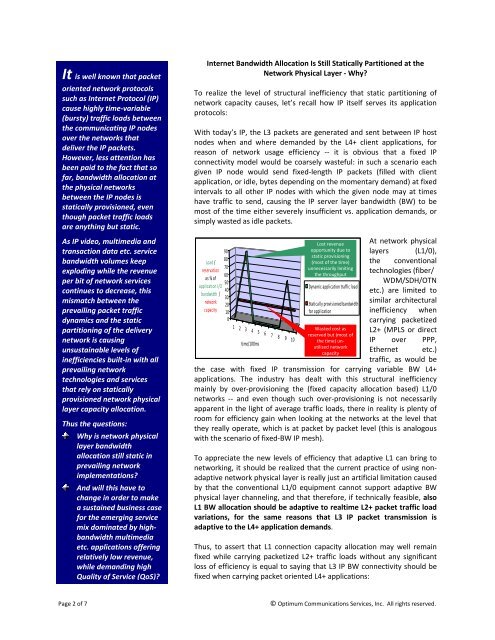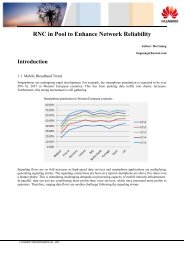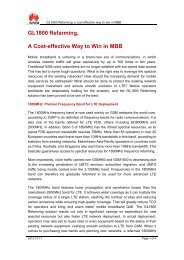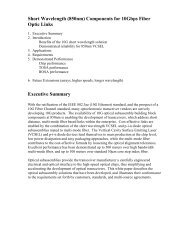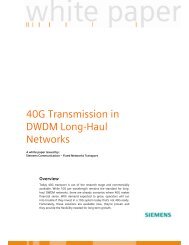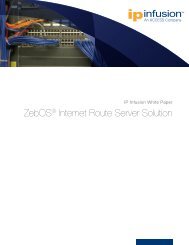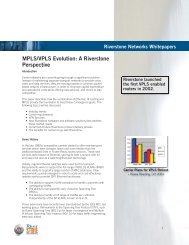Making High Bandwidth But Low Revenue Per Bit ... - Light Reading
Making High Bandwidth But Low Revenue Per Bit ... - Light Reading
Making High Bandwidth But Low Revenue Per Bit ... - Light Reading
You also want an ePaper? Increase the reach of your titles
YUMPU automatically turns print PDFs into web optimized ePapers that Google loves.
It is well known that packet<br />
oriented network protocols<br />
such as Internet Protocol (IP)<br />
cause highly time‐variable<br />
(bursty) traffic loads between<br />
the communicating IP nodes<br />
over the networks that<br />
deliver the IP packets.<br />
However, less attention has<br />
been paid to the fact that so<br />
far, bandwidth allocation at<br />
the physical networks<br />
between the IP nodes is<br />
statically provisioned, even<br />
though packet traffic loads<br />
are anything but static.<br />
As IP video, multimedia and<br />
transaction data etc. service<br />
bandwidth volumes keep<br />
exploding while the revenue<br />
per bit of network services<br />
continues to decrease, this<br />
mismatch between the<br />
prevailing packet traffic<br />
dynamics and the static<br />
partitioning of the delivery<br />
network is causing<br />
unsustainable levels of<br />
inefficiencies built‐in with all<br />
prevailing network<br />
technologies and services<br />
that rely on statically<br />
provisioned network physical<br />
layer capacity allocation.<br />
Thus the questions:<br />
Why is network physical<br />
layer bandwidth<br />
allocation still static in<br />
prevailing network<br />
implementations?<br />
And will this have to<br />
change in order to make<br />
a sustained business case<br />
for the emerging service<br />
mix dominated by high‐<br />
bandwidth multimedia<br />
etc. applications offering<br />
relatively low revenue,<br />
while demanding high<br />
Quality of Service (QoS)?<br />
Internet <strong>Bandwidth</strong> Allocation Is Still Statically Partitioned at the<br />
Network Physical Layer ‐ Why?<br />
To realize the level of structural inefficiency that static partitioning of<br />
network capacity causes, let’s recall how IP itself serves its application<br />
protocols:<br />
With today’s IP, the L3 packets are generated and sent between IP host<br />
nodes when and where demanded by the L4+ client applications, for<br />
reason of network usage efficiency ‐‐ it is obvious that a fixed IP<br />
connectivity model would be coarsely wasteful: in such a scenario each<br />
given IP node would send fixed‐length IP packets (filled with client<br />
application, or idle, bytes depending on the momentary demand) at fixed<br />
intervals to all other IP nodes with which the given node may at times<br />
have traffic to send, causing the IP server layer bandwidth (BW) to be<br />
most of the time either severely insufficient vs. application demands, or<br />
simply wasted as idle packets.<br />
90<br />
80<br />
Load /<br />
70<br />
reservation<br />
60<br />
as % of<br />
50<br />
application I/O<br />
40<br />
bandwidth /<br />
30<br />
network<br />
20<br />
capacity 10<br />
0<br />
1 2 3 4 5 6 7 8 9 10<br />
time/100ms<br />
Lost revenue<br />
opportunity due to<br />
static provisioning<br />
(most of the time)<br />
unnecessarily limiting<br />
the throughput<br />
Dynamic application traffic load<br />
Statically provisioned bandwidth<br />
for application<br />
Wasted cost as<br />
reserved but (most of<br />
the time) un‐<br />
utilized network<br />
capacity<br />
At network physical<br />
layers (L1/0),<br />
the conventional<br />
technologies (fiber/<br />
WDM/SDH/OTN<br />
etc.) are limited to<br />
similar architectural<br />
inefficiency when<br />
carrying packetized<br />
L2+ (MPLS or direct<br />
IP over PPP,<br />
Ethernet etc.)<br />
traffic, as would be<br />
the case with fixed IP transmission for carrying variable BW L4+<br />
applications. The industry has dealt with this structural inefficiency<br />
mainly by over‐provisioning the (fixed capacity allocation based) L1/0<br />
networks ‐‐ and even though such over‐provisioning is not necessarily<br />
apparent in the light of average traffic loads, there in reality is plenty of<br />
room for efficiency gain when looking at the networks at the level that<br />
they really operate, which is at packet by packet level (this is analogous<br />
with the scenario of fixed‐BW IP mesh).<br />
To appreciate the new levels of efficiency that adaptive L1 can bring to<br />
networking, it should be realized that the current practice of using non‐<br />
adaptive network physical layer is really just an artificial limitation caused<br />
by that the conventional L1/0 equipment cannot support adaptive BW<br />
physical layer channeling, and that therefore, if technically feasible, also<br />
L1 BW allocation should be adaptive to realtime L2+ packet traffic load<br />
variations, for the same reasons that L3 IP packet transmission is<br />
adaptive to the L4+ application demands.<br />
Thus, to assert that L1 connection capacity allocation may well remain<br />
fixed while carrying packetized L2+ traffic loads without any significant<br />
loss of efficiency is equal to saying that L3 IP BW connectivity should be<br />
fixed when carrying packet oriented L4+ applications:<br />
Page 2 of 7 © Optimum Communications Services, Inc. All rights reserved.


